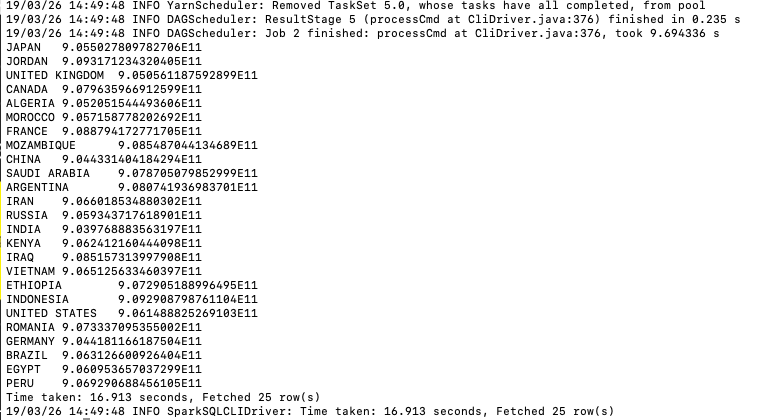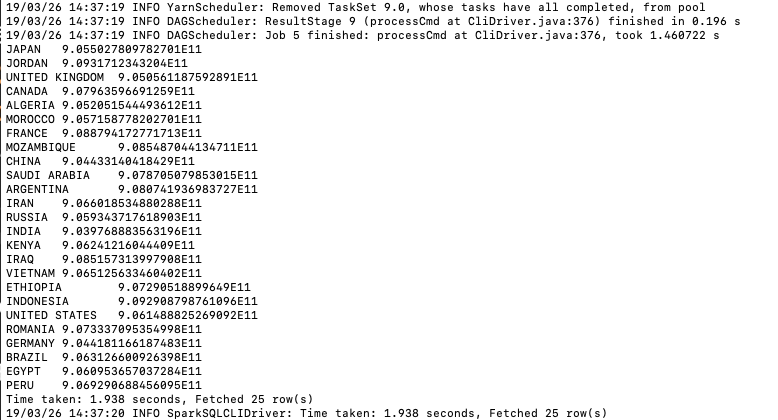Cache can broadly be defined as hardware or software of some kind that is used in various fields and directions of data processing. For many computing devices, I/O access speeds are highly dependent on the storage medium used for caching. As such, typically, the I/O access speeds of HDDs slower than SDDs, which are slower than NVMes, which comes after Mem, and L3-L2-L1 Cache, and Register, and the CPU. Generally speaking, the closer the storage device is to the CPU, the lower the speed gap between computing and I/O access, and the faster the data processing speed. However, the costs increase as speeds increase, with capacity typically decreasing as well. Cache pushes the data to be processed closer to the computation at the cost of more resource consumption, accelerating data processing operations, and filling the gap between computing and I/O access speeds.
For Spark, specifically, file systems, such as HDFS cache and Alluxio, provide file-level cache services. By caching files to the memory, the data processing speed is accelerated, and it is completely transparent to computing frameworks, such as Spark.
In addition, another method for caching is also available. If the same data needs to be processed multiple times, and the processing logic is similar, we can cache the intermediate results, so that each time we process the data, we start processing from the intermediate results, eliminating the computation from the original data to the intermediate results. Cached data is closer to the computing result. Compared with the original data, the results can be obtained through less computation, and the processing speed can also be accelerated. Materialized views in data warehouses are typical applications of this cache type.
Spark also provides dataset-level cache. You can use SQL DDLs or Dataset APIs to cache relational data (not files) with schema information located in the memory. Subsequent data processing based on the dataset can save time for computing the dataset by directly reading the cached data in the memory. Unlike the materialized view in data warehouses, the current Spark dataset cache still has many shortcomings:
Because of the shortcomings mentioned above, Spark dataset cache is not widely used in practical applications, and it often cannot meet the requirements of interactive analysis scenarios, such as Star model-based multi-dimensional data analysis. Generally, the cube is built in advance and the SQL execution plan is rewritten, so to meet the sub-second level interactive analysis requirements. Relational Cache, conversely, aims to take into account the usability of Spark dataset cache and the optimization efficiency of materialized views. Its main objectives include:
EMR Spark extends Spark to implement Relational Cache. Our work includes the following:
Let's see how you can create a relational cache.
CACHE [LAZY] TABLE table_name
[REFRESH ON (DEMAND | COMMIT)]
[(ENABLE | DISABLE) REWRITE]
[USING datasource
[OPTIONS (key1=val1, key2=val2, ...)]
[PARTITIONED BY (col_name1, col_name2, ...)]
[ZORDER BY (col_name3, col_name4, ...)]
[CLUSTERED BY (col_name5, col_name6, ...) INTO num_buckets BUCKETS]
[COMMENT table_comment]
[TBLPROPERTIES (key1=val1, key2=val2, ...)]]
[AS select_statement]The syntax for creating a cache is shown above. We can use this syntax to cache any Spark table or view, and support data formats (such as Json, Parquet, and ORC), data sources (such as HDFS, and OSS), and the organization of cached data (such as Partition, Bucket and Z-order).
In the above syntax, REFRESH ON (DEMAND || COMMIT) specifies how the cache is updated - whether it is automatically updated when the base table data is updated (in COMMIT mode), or whether the user manually triggers the update by updating DDL (in DEMAND mode). Next, (ENABLE | DISABLE) REWRITE specifies whether to allow the cache to be used for subsequent execution plan optimization.
In addition, EMR Spark provides and extends more Relational Cache-related DDLs for adding, deleting, modifying, and querying the cache.
UNCACHE TABLE [IF EXISTS] table_name
ALTER TABLE table_name (ENABLE | DISABLE) REWRITE
ALTER TABLE table_name REFRESH ON (DEMAND | COMMIT)
REFRESH TABLE cache_name
SHOW CACHES
(DESC | DESCRIBE) (EXTENDED | FORMATTED) table_nameEMR Spark also provides session-level parameters to control whether to enable Relational Cache-based execution plan optimization. Users can enable or disable execution plan optimization through the spark.sql.cache.queryRewrite parameter.
Next, you can optimize queries with Relational Cache. The following is a simple example of how the Relational Cache optimizes Spark queries. The original SQL query is:
SELECT n_name, sum(o_totalprice)
FROM orders, customer, nation
WHERE o_custkey = c_custkey AND c_nationkey = n_nationkey
GROUP BY n_nameThe corresponding physical execution plan includes two Join and two Aggregate operations, with an execution time of 16.9s, as shown below:
== Physical Plan ==
*(7) HashAggregate(keys=[n_name#36], functions=[sum(o_totalprice#10)])
+- Exchange hashpartitioning(n_name#36, 200)
+- *(6) HashAggregate(keys=[n_name#36], functions=[partial_sum(o_totalprice#10)])
+- *(6) Project [o_totalprice#10, n_name#36]
+- *(6) BroadcastHashJoin [c_nationkey#30L], [n_nationkey#35L], Inner, BuildRight
:- *(6) Project [o_totalprice#10, c_nationkey#30L]
: +- *(6) SortMergeJoin [o_custkey#8L], [c_custkey#27L], Inner
: :- *(2) Sort [o_custkey#8L ASC NULLS FIRST], false, 0
: : +- Exchange hashpartitioning(o_custkey#8L, 200)
: : +- *(1) Project [o_custkey#8L, o_totalprice#10]
: : +- *(1) Filter isnotnull(o_custkey#8L)
: : +- *(1) FileScan parquet tpch_sf100_parquet.orders[o_custkey#8L,o_totalprice#10,o_orderdate#15] Batched: true, Format: Parquet, Location: CatalogFileIndex[hdfs://emr-header-1:9000/tpch/sf100_parquet/tpch/sf100_parquet/orders], PartitionCount: 2406, PartitionFilters: [], PushedFilters: [IsNotNull(o_custkey)], ReadSchema: struct<o_custkey:bigint,o_totalprice:double>
: +- *(4) Sort [c_custkey#27L ASC NULLS FIRST], false, 0
: +- Exchange hashpartitioning(c_custkey#27L, 200)
: +- *(3) Project [c_custkey#27L, c_nationkey#30L]
: +- *(3) Filter (isnotnull(c_custkey#27L) && isnotnull(c_nationkey#30L))
: +- *(3) FileScan parquet tpch_sf100_parquet.customer[c_custkey#27L,c_nationkey#30L,c_mktsegment#34] Batched: true, Format: Parquet, Location: CatalogFileIndex[hdfs://emr-header-1:9000/tpch/sf100_parquet/tpch/sf100_parquet/customer], PartitionCount: 5, PartitionFilters: [], PushedFilters: [IsNotNull(c_custkey), IsNotNull(c_nationkey)], ReadSchema: struct<c_custkey:bigint,c_nationkey:bigint>
+- BroadcastExchange HashedRelationBroadcastMode(List(input[0, bigint, true]))
+- *(5) Project [n_nationkey#35L, n_name#36]
+- *(5) Filter isnotnull(n_nationkey#35L)
+- *(5) FileScan parquet tpch_sf100_parquet.nation[n_nationkey#35L,n_name#36] Batched: true, Format: Parquet, Location: InMemoryFileIndex[hdfs://emr-header-1:9000/tpch/sf100_parquet/tpch/sf100_parquet/nation], PartitionFilters: [], PushedFilters: [IsNotNull(n_nationkey)], ReadSchema: struct<n_nationkey:bigint,n_name:string>
A Relational Cache can be created in two ways. You can create a view first, and then cache the data of the view through cache syntax, as follows:
CREATE VIEW nation_cust_cache AS
SELECT n_name, o_custkey, c_custkey, n_nationkey, c_nationkey, o_totalprice, o_orderstatus, o_orderdate
FROM orders, customer, nation
WHERE o_custkey = c_custkey AND c_nationkey = n_nationkey;
CACHE TABLE nation_cust_cache
ENABLE REWRITE
USING parquet;Alternatively, you can directly create a view and cache data.
CACHE TABLE nation_cust_cache
ENABLE REWRITE
USING parquet
AS
SELECT n_name, o_custkey, c_custkey, n_nationkey, c_nationkey, o_totalprice, o_orderstatus, o_orderdate
FROM orders, customer, nation
WHERE o_custkey = c_custkey AND c_nationkey = n_nationkey;After the data is cached, we re-execute the user query SQL. The execution plan is as follows:
== Physical Plan ==
*(2) HashAggregate(keys=[n_name#35], functions=[sum(o_totalprice#20)])
+- Exchange hashpartitioning(n_name#35, 200)
+- *(1) HashAggregate(keys=[n_name#35], functions=[partial_sum(o_totalprice#20)])
+- *(1) Project [o_totalprice#20, n_name#35]
+- *(1) Filter (((isnotnull(o_custkey#18L) && isnotnull(c_custkey#26L)) && isnotnull(c_nationkey#29L)) && isnotnull(n_nationkey#34L))
+- *(1) FileScan parquet tpch_sf100_parquet._cache_nation_cust_cache[n_name#35,o_custkey#18L,c_custkey#26L,n_nationkey#34L,c_nationkey#29L,o_totalprice#20] Batched: true, Format: Parquet, Location: FullScanFileMetaWithStats[hdfs://emr-header-1.cluster-100048:9000/user/hive/warehouse/tpch_sf100_..., PartitionFilters: [], PushedFilters: [IsNotNull(o_custkey), IsNotNull(c_custkey), IsNotNull(c_nationkey), IsNotNull(n_nationkey)], ReadSchema: struct<n_name:string,o_custkey:bigint,c_custkey:bigint,n_nationkey:bigint,c_nationkey:bigint,o_to...
We can see that the cache-based optimized execution plan directly reads data from the cache, saving the computing time of two Join operations. The overall execution time also reduced from 16.9s to 1.9s.
The powerful functions of the Relational Cache give Spark more possibilities. With the Relational Cache, you can cache any Relational data, such as tables, views, and datasets, to any data source supported by Spark in advance, and can flexibly organize the cached data. As such, the Relational Cache can help you accelerate Spark data analysis in many application scenarios. In specific application scenarios, for example, aggregation analysis of multi-dimensional data in the Star model, a sub-second response of PB-level data can be achieved.
Use EMR Spark Relational Cache to Synchronize Data Across Clusters

62 posts | 6 followers
FollowAlibaba Clouder - July 21, 2020
Alibaba EMR - December 2, 2019
Alibaba EMR - August 28, 2019
AdrianW - August 22, 2019
Alibaba EMR - December 2, 2019
Alibaba Clouder - April 14, 2021

62 posts | 6 followers
Follow Big Data Consulting for Data Technology Solution
Big Data Consulting for Data Technology Solution
Alibaba Cloud provides big data consulting services to help enterprises leverage advanced data technology.
Learn More Cloud Migration Solution
Cloud Migration Solution
Secure and easy solutions for moving you workloads to the cloud
Learn More Big Data Consulting Services for Retail Solution
Big Data Consulting Services for Retail Solution
Alibaba Cloud experts provide retailers with a lightweight and customized big data consulting service to help you assess your big data maturity and plan your big data journey.
Learn More Data Lake Storage Solution
Data Lake Storage Solution
Build a Data Lake with Alibaba Cloud Object Storage Service (OSS) with 99.9999999999% (12 9s) availability, 99.995% SLA, and high scalability
Learn MoreMore Posts by Alibaba EMR
Start building with 50+ products and up to 12 months usage for Elastic Compute Service
Get Started for Free Get Started for Free